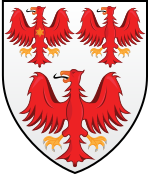The Queen's College
| The Queen's College | |
|---|---|
 |
|

Blazon: Argent, three eagles displayed gules, beaked and legged or, on the breast of the first, a mullet of six points of the last.
|
|
| University | Oxford |
| Location | High Street, Oxford |
| Coordinates | 51°45′11″N 1°15′04″W / 51.753187°N 1.251043°WCoordinates: 51°45′11″N 1°15′04″W / 51.753187°N 1.251043°W |
| Full name | The Provost and Scholars of The Queen's College in the University of Oxford |
| Latin name | Collegium Reginae |
| Established | 1341 |
| Named for | Philippa of Hainault |
| Sister college | Pembroke College, Cambridge |
| Provost | Paul Madden |
| Undergraduates | 349 (2011/2012) |
| Postgraduates | 133 |
| Website | www |
| Boat club | Boatclub |
| Map | |
The Queen's College is a constituent college of the University of Oxford, England. The college was founded in 1341 by Robert de Eglesfield (d'Eglesfield) in honour of Queen Philippa of Hainault (wife of King Edward III of England). The college is distinguished by its predominantly neoclassical architecture, which includes buildings designed by Sir Christopher Wren and Nicholas Hawksmoor.
In 2015, the college had an endowment of £265 million, making it the fifth wealthiest college (after St. John's, Christ Church, All Souls and Merton).
The college was founded in 1341 as "Hall of the Queen's scholars of Oxford" by Robert de Eglesfield (d'Eglesfield), chaplain to Queen Philippa of Hainault (the wife of King Edward III of England), after whom the hall was named. Robert's aim was to provide clergymen for his native Cumberland and where he lived in Westmorland (both part of modern Cumbria). In addition the college was to provide charity for the poor. The college's coat of arms is that of the founder; it differs slightly from his family's coat of arms, which did not include the gold star on the breast of the first eagle. The current coat of arms was adopted by d'Eglesfield because he was unable to use his family's arms, being the younger son. d'Eglesfield had grand plans for the college with a provost, twelve fellows studying theology, up to thirteen chaplains, and seventy-two poor boys. However the college did not have the funding to support such numbers and initially had just two fellows.
...
Wikipedia

